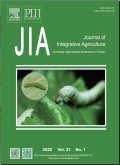EPSPS regulates cell elongation by disrupting the balance of lignin and flavonoid biosynthesis in cotton
Qingdi Yan Wei Hu Chenxu Gao Lan Yang Jiaxian Yang Renju Liu Masum Billah Yongjun Lin Ji Liu Pengfei Miao Zhaoen Yang Fuguang Li Wenqiang Qin
EPSPS regulates cell elongation by disrupting the balance of lignin and flavonoid biosynthesis in cotton
摘要
关键词
EPSPS/cotton/T-DNA/dwarfism/herbicide resistance分类
农业科学引用本文复制引用
Qingdi Yan,Wei Hu,Chenxu Gao,Lan Yang,Jiaxian Yang,Renju Liu,Masum Billah,Yongjun Lin,Ji Liu,Pengfei Miao,Zhaoen Yang,Fuguang Li,Wenqiang Qin..EPSPS regulates cell elongation by disrupting the balance of lignin and flavonoid biosynthesis in cotton[J].Journal of Integrative Agriculture,2024,23(10):P.3437-3456,20.基金项目
supported by funding from the Natural Science Foundation of Henan Province,China(232300421010) (232300421010)
the Key Research and Development Project of Henan Province,China(231111110400) (231111110400)
the Hainan Provincial Joint Project of Sanya Yazhou Bay Science and Technology City,China(320LH045) (320LH045)
the Hainan Yazhou Bay Seed Laboratory,China(B21HJ0215) (B21HJ0215)
the Fundamental Research Funds of State Key Laboratory of Cotton Biology,China(2021CBE03) (2021CBE03)
the Central Public-interest Scientific Institution Basal Research Fund,China(Y2023XK16) (Y2023XK16)
the Innovation Program of the Chinese Academy of Agricultural Sciences(CAAS-ASTIPIVFCAAS to F.G.L)。 (CAAS-ASTIPIVFCAAS to F.G.L)

